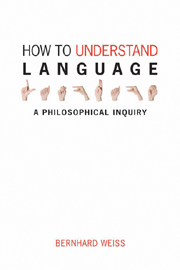Book contents
- Frontmatter
- Contents
- Preface
- 1 The puzzles of language
- 2 The starting-point for analysis
- 3 Analysing sentence-meaning
- 4 Analysing synonymy
- 5 Radical translation
- 6 The structure of a theory of meaning
- 7 Radical interpretation
- 8 Linguistic norms, communication and radical interpretation
- 9 Linguistic normativity
- 10 Radical or robust?
- 11 Language and community
- 12 Rules and privacy: the problem
- 13 Rules and privacy: the solution?
- 14 Truth-conditions versus use-conditions
- Notes
- Bibliography
- Index
6 - The structure of a theory of meaning
- Frontmatter
- Contents
- Preface
- 1 The puzzles of language
- 2 The starting-point for analysis
- 3 Analysing sentence-meaning
- 4 Analysing synonymy
- 5 Radical translation
- 6 The structure of a theory of meaning
- 7 Radical interpretation
- 8 Linguistic norms, communication and radical interpretation
- 9 Linguistic normativity
- 10 Radical or robust?
- 11 Language and community
- 12 Rules and privacy: the problem
- 13 Rules and privacy: the solution?
- 14 Truth-conditions versus use-conditions
- Notes
- Bibliography
- Index
Summary
Two recent chapters (3 and 5) have closed with suggestions about theories of meaning: in Chapter 3 we left Schiffer speculating on how a Gricean approach might be developed to give a systematic explanation of the meanings of words and compounds thereof – the upshot of this project would be a theory of meaning; and Chapter 5 suggested that the indeterminacy of translation reveals no deep truth about the nature of meanings but an inadequacy in the project of translation, which should therefore be replaced by that of constructing a theory of meaning. The preliminaries to that project are sketched in this chapter.
What is a theory of meaning?
A terminological nicety for openers: there is an ambiguity here that, on occasion, it will be important to guard against. “Theory of meaning” is often taken to signify a view about the nature of meaning or, quite distinctly, a theory that specifies or delivers specifications of the meanings of all expressions in some given language. Michael Dummett suggests the following disambiguating terminology. Let “meaning-theory” stand for the second use and let “theory of meaning” stand for the first use. Then we can talk about the philosophical discipline that is the theory of meaning and about a meaning-theory for Xhosa, or for Spanish or for Hebrew. The current proposal is thus that the best way of pursuing the theory of meaning is to consider how one would construct, and what form would be taken by a meaning-theory.
- Type
- Chapter
- Information
- How to Understand LanguageA Philosophical Inquiry, pp. 81 - 94Publisher: Acumen PublishingPrint publication year: 2009



